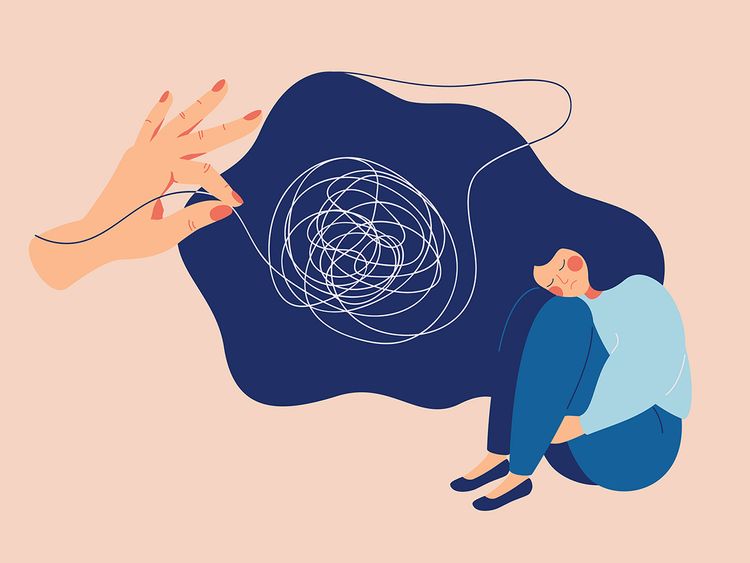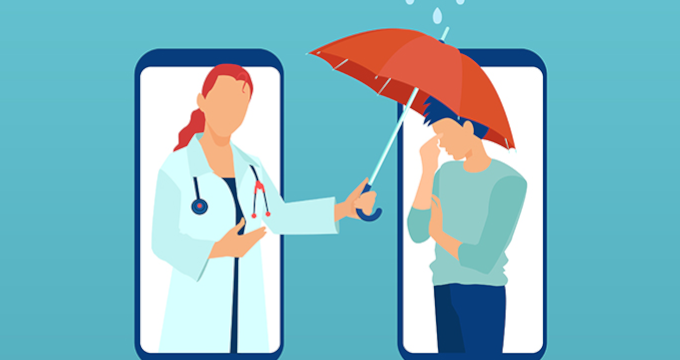Mental healthcare is a lucrative field for implementing digital solutions. The recent stats on the proliferation of mental disorders show there’s a huge demand for apps built to alleviate difficult mental states and emotional ailments: one in five US adults is experiencing a mental disorder, and only 41% of all US mental disorder patients are getting professional care.
The post-pandemic ‘new normal’ has added isolation to the mix of negative influences and urged many people to seek help online. In our previous article, we have outlined the key things that you need to consider before building mental health apps. In this blog, we are going to list the core features of digital solutions for mental healthcare. Read on to learn more!

Types of Mental Health Apps
Mental health apps may target general audiences or aim at alleviating and managing specific conditions like anxiety, schizophrenia, or major depression. In a nutshell, existing solutions for mental healthcare may be subdivided into the following categories:
General mental health apps: mood tracking, meditation, and self-discovery are the core themes covered by these solutions.
Dedicated mental health apps: apps for tackling specific diagnoses and conditions.
Self-improvement apps: these apps help people reach specific goals like leading a healthier lifestyle and ditching harmful habits.
Treatment monitoring apps: these apps help users follow through with the treatment routines assigned by their therapists.
There’s also a segment of educational apps aimed at providing information about a specific mental health condition and treatment, and apps for connecting with peers facing the same problem.
Must-Have Features of Mental Health Apps
Surely, the app you decide to build will need its unique feature set in to differentiate it from competitors. Some features, though, have already become a golden standard for apps in the mental health segment. The checklist below should offer you enough guidelines:
For users:
Sign-in/Registration: Users should be able to register, customize their profiles, and quickly access them to use the application features.
User profile: People with anxiety and depression may be unwilling to share their personal details, yet, a user profile is an absolutely necessary feature for a mental health app. Think about which details you need to know about your users in order to enable them to use your platform.
Tracking features: Tracking thoughts, emotional states, achievements, and milestones is essential for people facing mental health challenges.
Connecting patients and therapists: If you plan on building a teletherapy platform for mental health, make sure to introduce the feature for connecting patients and mental health professionals.
Chat and messaging: Secure video and text messaging options are also an absolute must for telehealth platforms.
User communities: Peer communities and support groups can be especially helpful in helping people overcome their issues.
For therapists and consultants:
Registration/Sign-in: Registration should be secure and easy for mental health professionals.
Profile: The user profile of a therapist/consultant should provide detailed information about their qualification, license, and practical experience.
Appointment calendar: The calendar should show free and occupied time slots and help doctors manage their appointments.
Dashboards and treatment plans: Mental health practitioners should be able to build treatment plans and see how patients progress.
Additional features:
Apart from the core feature set, the app you plan to build may optionally include:
Calendars and checklists: Patients may find these features helpful for regaining control of their lives.
Sleep tracking: This feature requires integration with wearable devices, like fitness bracelets. Sleep tracking is especially useful for patients with high levels of anxiety or dealing with major depression.
Trigger checkers: Users may input what has triggered their negative thoughts and emotional states and later discuss it with their therapists.
Pill reminder features: Some people may need additional help following through their medication routines. In this regard, pill reminders could be especially helpful.
Journaling features: Some people may find keeping journals helpful in handling difficult emotional states and conditions. A journaling feature could become a useful addition to your app.
Urgent help button: The users should be able to quickly contact their mental health professional, friends, and relatives in case they need urgent help.
One important rule of thumb is to pay attention to the UI/UX of your mental health app. The interface should have a pleasant and non-intrusive look and feel, and provide easy navigation and access.
Final Thoughts
Although the market for mental health apps is quite vast, existing solutions are still far from perfect. In terms of usability, efficiency, and security, there is lots of room for improvement. Using evidence-based therapeutic approaches, complying with laws and regulations, and collaborating with certified mental health professionals could help you gain the upper hand and build a top-notch app for mental health.
At VARTEQ we have all it takes for bringing your app ideas to life. Thinking about building a mental health app? Contact us now for a free consultation.

